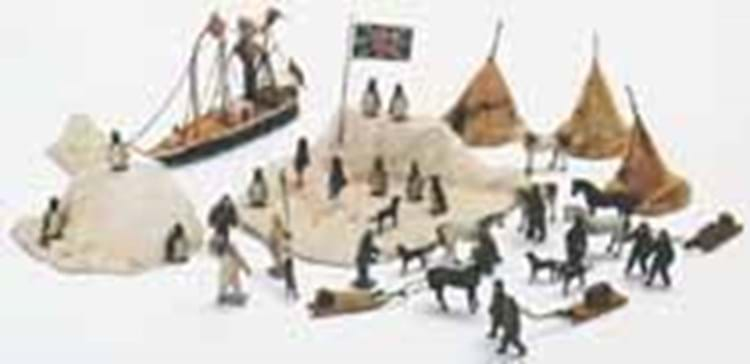
In his hands, ordinary marching and firing figures became ceremonial parades of Roman soldiers, armies of mounted elephants, galloping foxhunts and teams of sportsmen.
While he made only modest inroads in his own country - in Germany the 'flat' soldier was king - he had great success in the international market, particularly Britain and the USA.
Likely among his UK exports was the rare group of figures depicting a team of polar explorers offered for sale by Lewes toy and militaria auctioneers Wallis & Wallis on August 31.
This unboxed set comprised a ship, the Nimrod, three tents, three sleds containing provisions, nine huskies, three icebergs/snowhills, two Union flags, a team of ponies and nine penguins. The exact number of components as sold by Heyde is unknown, but here there were also 11 figures including the exhibition leader modelled with his arm raised aloft.
While the auctioneers were under the impression that this rare group represented the protagonists of Scott's Antarctic Expedition of 1912, the name of the ship will have suggested otherwise to those familiar with the history of Polar exploration.
Some time before his ill-fated, but heroic, Endurance expedition to Antarctica in 1914-1917, and following the Discovery expedition he undertook under Robert Scott in 1902, Ernest Shackleton had led his first expedition to the continent in 1907-1909. His ship was the aging sealer Nimrod.
In addition to a motor car especially adapted for Polar conditions, Shackleton had brought ponies for transport, but - in addition to the injury to meteorologist Jameson Adams on the first day - they became weak in temperatures consistently below minus 20 degrees centigrade. The weakest pony was shot on November 21 to aid the short rations and two more had to be sacrificed soon after the party passed the point (480 miles from the Pole) reached by Scott and Shackleton in 1902.
Christmas was celebrated with plum pudding, brandy, cigars and a spoonful of crème de menthe, but on January 9, with the blizzards against them on a polar plateau at an altitude of 10,200 feet, they reached their furthest south point just 97 miles from the Pole. A flag was planted and photographs taken, they turned around and began to head for home. "I thought, dear, that you would rather have a live ass than a dead lion," Sir Ernest Shackleton wrote to his wife Emily. In total they walked 1700 miles.
Such a story made the Nimrod Expedition a more than suitable topic for a young boy's playroom, but evidently very few of the sets were made.
Knowledgeable clients viewing the sale at the West Street Auction Rooms guessed it was worth in the region of £1500 (the estimate was £600-1000), but no one could remember the last time a set of this magnitude (and in this all-original condition) had come up for auction. A bidding battle ensued between a postal bidder and room bidders before a new paddle (a dealer possibly acting for a German collector) came in at the last moment with a winning £4100 (plus 15 per cent buyer's premium).




